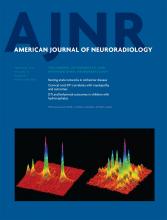Article CommentaryInterventional
Prospective Comparison of Angio-Seal versus Manual Compression for Hemostasis after Neurointerventional Procedures under Systemic Heparinization
H.-F. Wong, C.-W. Lee, Y.-L. Chen, Y.-M. Wu, H.-H. Weng, Y.-H. Wang and H.-M. Liu
American Journal of Neuroradiology February 2013, 34 (2) 397-401; DOI: https://doi.org/10.3174/ajnr.A3226
H.-F. Wong
aFrom the Department of Imaging and Intervention, Chang Gung Memorial Hospital at Linkou (H.-F.W., Y.-L.C., Y.-M.W.)
C.-W. Lee
cDepartment of Medical Imaging (C.-W.L., Y.-H.W., H.-M.L.), National Taiwan University Hospital, Taipei, Taiwan.
Y.-L. Chen
aFrom the Department of Imaging and Intervention, Chang Gung Memorial Hospital at Linkou (H.-F.W., Y.-L.C., Y.-M.W.)
Y.-M. Wu
aFrom the Department of Imaging and Intervention, Chang Gung Memorial Hospital at Linkou (H.-F.W., Y.-L.C., Y.-M.W.)
H.-H. Weng
bChiayi (H.-H.W.), College of Medicine and School of Medical Technology, Chang-Gung University, Taiwan
Y.-H. Wang
cDepartment of Medical Imaging (C.-W.L., Y.-H.W., H.-M.L.), National Taiwan University Hospital, Taipei, Taiwan.
H.-M. Liu
cDepartment of Medical Imaging (C.-W.L., Y.-H.W., H.-M.L.), National Taiwan University Hospital, Taipei, Taiwan.

References
- 1.↵
- Bogart DB,
- Bogart MA,
- Miller JT,
- et al
- 2.↵
- Heintzen MP,
- Strauer BE
- 3.↵
- Pracyk JB,
- Wall TC,
- Longabaugh JP,
- et al
- 4.↵
- Geyik S,
- Yavuz K,
- Akgoz A,
- et al
- 5.↵
- Khaghany K,
- Al-Ali F,
- Spigelmoyer T,
- et al
- 6.↵
- McTaggart RA,
- Raghavan D,
- Haas RA,
- et al
- 7.↵
- Morris PP,
- Braden G
- 8.↵
- Park Y,
- Roh HG,
- Choo SW,
- et al
- 9.↵
- Pierot L,
- Herbreteau D,
- Bracard S,
- et al
- 10.↵
- Koenigsberg RA,
- Wysoki M,
- Weiss J,
- et al
- 11.↵
- Cremonesi A,
- Castriota F,
- Tarantino F,
- et al
- 12.↵
- 13.↵
- Kussmaul WG 3rd.,
- Buchbinder M,
- Whitlow PL,
- et al
- 14.↵
- Sanborn TA,
- Gibbs HH,
- Brinker JA,
- et al
- 15.↵
- Schrader R,
- Steinbacher S,
- Burger W,
- et al
- 16.↵
- Silber S,
- Bjorvik A,
- Muhling H,
- et al
- 17.↵
- 18.↵
- 19.↵
- Semler HJ
- 20.↵
In this issue
Advertisement
Prospective Comparison of Angio-Seal versus Manual Compression for Hemostasis after Neurointerventional Procedures under Systemic Heparinization
H.-F. Wong, C.-W. Lee, Y.-L. Chen, Y.-M. Wu, H.-H. Weng, Y.-H. Wang, H.-M. Liu
American Journal of Neuroradiology Feb 2013, 34 (2) 397-401; DOI: 10.3174/ajnr.A3226
Prospective Comparison of Angio-Seal versus Manual Compression for Hemostasis after Neurointerventional Procedures under Systemic Heparinization
H.-F. Wong, C.-W. Lee, Y.-L. Chen, Y.-M. Wu, H.-H. Weng, Y.-H. Wang, H.-M. Liu
American Journal of Neuroradiology Feb 2013, 34 (2) 397-401; DOI: 10.3174/ajnr.A3226
Jump to section
Related Articles
- No related articles found.
Cited By...
- No citing articles found.
This article has been cited by the following articles in journals that are participating in Crossref Cited-by Linking.
- Vincent J. Noori, Jens Eldrup-JørgensenJournal of Vascular Surgery 2018 68 3
- Yasuhiro Aida, Kouichi Misaki, Tomoya Kamide, Masanao Mohri, Naoyuki Uchiyama, Mitsutoshi NakadaWorld Neurosurgery 2018 111
- Jacquelyn A. Corley, Manish K. Kasliwal, Lee A. Tan, Demetrius K. LopesJournal of Cerebrovascular and Endovascular Neurosurgery 2014 16 3
- Klaus A. Hausegger, Michael Hauser, Thomas KauCardioVascular and Interventional Radiology 2014 37 4
- Daniel Brancheau, Sinan Sarsam, Mahmoud Assaad, Marcel ZughaibTherapeutic Advances in Cardiovascular Disease 2018 12 5
- JayadevanE Rajan, SanthoshK Kannath, Sankara Sarma, TirurR KapilamoorthyNeurology India 2019 67 5
- Alexander Sauer, Alexander Dierks, Franziska Wolfschmidt, Nicole Hassold, Thorsten A. Bley, Ralph KickuthJournal of Endovascular Therapy 2016 23 5
- Muhammed Amir Essibayi, Harry Cloft, Luis E Savastano, Waleed BrinjikjiInterventional Neuroradiology 2021 27 5
- James Wareham, Sebastian Luppe, Adam Youssef, Robert Crossley, Alex MortimerInterventional Neuroradiology 2018 24 5
- Rejane Reich, Eneida Rejane Rabelo-Silva, Simone Marques dos Santos, Miriam de Abreu AlmeidaRevista Gaúcha de Enfermagem 2018 38 4
More in this TOC Section
Similar Articles
Advertisement










